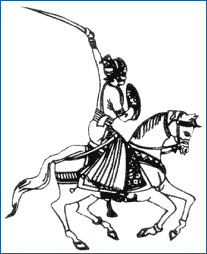
Maher Surnames
|
Vansh : Suryavanshi
Kachwaha (Kishwaha, Cutchwaha and Keshwala). Also sprang from Kusha. It has 12 kotri or houses.
Major subdivisions:
Gogawat, Kubhani, Naruka, Ladkhani, Tajkhani, Nathawat, Rajawat, Shekhawat, Jeetawat, Bankawat,Balbhadrot, Khangarot, Chaturbhujot.
This is a celebrated clan, which the maharajas Shekhawat (Jaipur and Alwar) belong to. They belong of solar race and claim descent from Kush, second son of Lord Ram (of Ayodhya). Their original rule, was over Rohtas on the Son river. Later Raja Nal migrated from Rohtas and founded Narwar. The town of Damoh in Madhya Pradesh is supposed to be named after Damyanti, Raja Nal’s wife.
The earliest appearance of the Kachhwaha rajputs in history is in the 10th century, when the chief Kachhwaha captured Gwalior from the Gurjara-Parihara kings of Kannauj and established a kingdom there.
His dynasty was independent until C.E 1128, when it became tributary to the Chandel kings of Mahoba. The last Kacchwaha king of Gwalior was Tejkaran, called Dulha Rai or the bridegroom-prince. He received from his father-in-law the district of Daora in the present Jaipur area, where he settled. In 1150 one of his successors wrested the city of Amber from the Minas and made it his capital. The Amber State from the first acknowledged the supremacy of the Mughal emperors, and the chief of the period gave his daughter in marriage to Akbar.
Maharaja Bhagwan Das is said to have saved Akbar’s life at the battle of Sarnal. He gave a daughter to Jahangir, and his adopted son, Man Singh, who at different periods was governor of Kabul, Bengal, Bihar and Deccan. The next chief of note, Jai Singh I, appears in all the wars of Aurangzeb in the Deccan. He was commander of 6000 horses. The present city of Jaipur was founded by a subsequent chief, Jai Singh II, in 1728. At the Durbar of 1877 his salute was raised with 21 guns. The Alwar State was founded about 1766 by Pratap Singh, a descendent of a prince of the Jaipur house, who had separated from it centuries ago.
The banner of Amber frequently mentioned by the bards was called Panchranga (5 colours). The Kachwahas are fairly numerous in UP and in MP are found in Saugor, Hoshangabad and Nimar Districts principally.
There are 65 gotras of Kachhwaha Rajputs (others include Rajawat, Shekawat, Nathawat, Khangarot, Ranawat). The Shekawat’s are the most influential of all of these.
The Kachhwahas of Jaipur are related to the Kachtries (Kuchi) of Baluchistan and the Kuchi of Afghanistan, according to some sources. The Kuchi tribe of Afghanistan is acknowledged for its tribal dance. They live in South-Eastern Afghanistan to the border of Pakistan. The Kuchi tribe of Afghanistan is nomadic, accustomed to moving annually with their herds between summer pastures in Afghanistan and winter pastures in Pakistan.
Article supplied by Kishan V Sisodia ; edited by Ravi Odedra.
